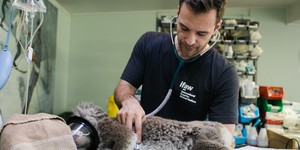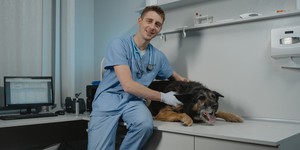Abstract
When you're chasing after your dog, do you ever stop and say, "Wait, I have to catch my breath!"? Do you think that there are times when your dog feels like that, too? Does your dog's respiration rate change when you two are playing active games together? Try this playful science project to find out!Summary
Sandra Slutz, PhD, Science Buddies
This project is based on a DragonflyTV episode.
Frisbee® is a registered trademark of Wham-o Inc.Objective
In this science fair project you will investigate how your dog's respiration rate is affected by active play.
Introduction
Did you know that you can see and feel your dog's breath? Each time your dog draws in a breath of air, or inhales, the lungs fill up with oxygen. When the lungs fill up, it is similar to a balloon expanding, and the lungs need more room. To create space, the diaphragm, a muscle just below the lungs, flattens out and moves downward. Oxygen from the freshly inhaled air is taken from the lungs and circulated throughout the dog's body. In exchange, carbon dioxide, which has been created by the dog, is carried into the lungs. Once the oxygen has been replaced by carbon dioxide, the dog is ready to exhale, or breathe out. In order to make this happen, the diaphragm moves back up, forcing the air out of the lungs. Imagine using your hand to push down on a balloon and squeezing the air out. It is the up-and-down movement of the diaphragm during inhalation and exhalation that is visible just under the ribs of your dog. Try watching your dog as he or she sleeps-can you see the movement? Can you feel it if you put your hand on his or her side?
The frequency with which your dog breathes is called the respiration rate. Respiration rate can be a sign of how healthy your dog is. Veterinarians use respiration rates to help them diagnose when a dog is sick.
The harder a dog works, the more oxygen he or she needs. Does this mean that a dog's respiration rate increases when he or she exercises? You can have fun with your dog and discover the answer by doing a science project comparing your dog's respiration rate at rest with the rate immediately after you two have played an active game. Have fun playing and experimenting!
Terms and Concepts
Here are some words you should understand and some questions you should be able to answer before you start your science project. Ask an adult for help looking these up in books or on the Internet.
- Inhalation
- Oxygen
- Diaphragm
- Carbon dioxide
- Exhalation
- Respiration rate
Questions
- What happens during inhalation and exhalation?
- What is respiration rate?
- How is respiration rate measured in dogs?
- What is considered a healthy respiration rate for a dog?
- How can you exercise a dog?
Bibliography
This science fair project was based on this DragonflyTV Podcast:
- TPT. (2006). Sled Dogs by Alexa, Jenaya, and Miriah. DragonflyTV, Twin Cities Public Television. Retrieved May 3, 2008.
These resources can provide you with more information on how to play with dogs and give them exercise.
- Rock, Maxine. Totally Fun Things to Do with Your Dog. United States of America: John Wiley & Sons, Inc., 1998.
- American Kennel Club. The Complete Dog Book for Kids. New York: Hungry Minds, Inc., 1996.
- American Kennel Club. (2023, February 8). How Much Exercise Does a Dog Need Every Day?. Retrieved May 12, 2023.
Visit this website for an overview of the dog's lungs and other anatomy involved in respiration.
- College of Veterinary Medicine, Washington State University. (2022, January 4). Cat and dog anatomy. Retrieved May12, 2023.
Visit these websites for more information on the role of the respiratory system. Although the websites refer to humans, the same processes occur in dogs.
- The Franklin Institute Science Museum. (2008). Respiratory System: Oxygen Delivery System. Retrieved May 5, 2008.
- Inselman, L. (2006, August). Your Lungs & Respiratory System. Retrieved May 5, 2008.
For help creating graphs, try this website:
- National Center for Education Statistics. (n.d.). Create a Graph. Retrieved May 5, 2008.
Materials and Equipment
- Dog
- Stopwatch
- Helper
- Lab notebook
- Graph paper
Experimental Procedure
To do this science project you will have to learn how to measure your dog's respiration rate. Practice doing this before you begin your experiment.
How to Measure Respiration Rate
- Have your helper start the stopwatch and say "go."
-
As soon as your helper says "go," count each time your dog inhales.
- You can tell when your dog is inhaling because the rib cage will move outward as he or she draws in air.
- If you find it difficult to see the inhalations, try feeling them instead by placing your hand on the dog's side.
- After 15 seconds have passed on the stopwatch, your helper should say "stop."
- As soon as you hear "stop," you should quit counting the inhalations. Record the total number of inhalations in your lab notebook.
- Take the total number of inhalations you counted in those 15 seconds and multiply by 4. This will give you the number of inhalations per minute, which is your pet's respiration rate.
Experiment
- Using the method outlined above, measure your dog's respiration rate when he or she is relaxed. This is the resting respiration rate. Record your measurements in a data table, like the one below, in your lab notebook.
-
Play an active game with your dog for 15 minutes so that he or she moves around a lot and gets exercise. Have your helper use the stopwatch to tell you when the 15 minutes are over. Possible games include:
- Playing fetch with a ball, Frisbee®, or stick
- Playing a game of chase
- Playing tug-of-war
- Going for a brisk walk or run with your dog
- Immediately after the 15 minutes of playing are over, measure your dog's respiration rate again, using the method above. This is the active respiration rate. Record your measurements in your data table.
| Resting Respiration Rate | Active Respiration Rate | |||
|---|---|---|---|---|
| Number of Inhalations per 15 Seconds | Respiration Rate (Number of Inhalations x 4) |
Number of Inhalations per 15 Seconds | Respiration Rate (Number of Inhalations x 4) |
|
| Day 1 | ||||
| Day 2 | ||||
| Day 3 | ||||
- Repeat steps 1-3 of the experiment on two additional days for a total of three trials. Be sure to record all your data in the data table in your lab notebook.
Analyzing Your Data
-
In the DragonflyTV video, Alexa, Jenaya, and Miriah used a bar chart to analyze their data. Using your graph paper, draw a bar chart of your data.
- For day 1, make a bar for the resting respiration rate, and a bar next to it for the active respiration rate. The bars should be as many squares high as the rate. So if the resting respiration rate was 16, the bar for it should be 16 squares tall. Label each bar so you know what it represents.
- Using the same method, make bars for the data from days 2 and 3.
- If you prefer to make your bar chart on the computer, try using Create a Graph.
- Did active play cause an increase in your dog's respiration rate? Did you observe the same pattern on all three days?
Ask an Expert
Variations
- Does exercise change the respiration rate of other animals? Find out by trying this experiment with a cat, or even yourself!
- Do puppies and adult dogs have the same resting respiration rates? How about active respiration rates? Run an experiment to find out the answer.
- Do different breeds of dogs have different respiration rates? Compare the resting respiration rates of a small breed of dog (under 15 pounds) to a large breed of dog (over 60 pounds).
Careers
If you like this project, you might enjoy exploring these related careers:








